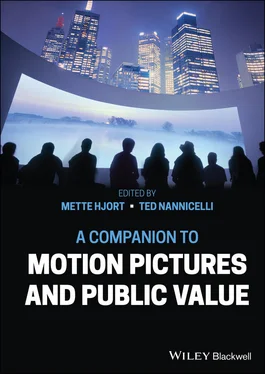A Companion to Motion Pictures and Public Value
Здесь есть возможность читать онлайн «A Companion to Motion Pictures and Public Value» — ознакомительный отрывок электронной книги совершенно бесплатно, а после прочтения отрывка купить полную версию. В некоторых случаях можно слушать аудио, скачать через торрент в формате fb2 и присутствует краткое содержание. Жанр: unrecognised, на английском языке. Описание произведения, (предисловие) а так же отзывы посетителей доступны на портале библиотеки ЛибКат.
- Название:A Companion to Motion Pictures and Public Value
- Автор:
- Жанр:
- Год:неизвестен
- ISBN:нет данных
- Рейтинг книги:3 / 5. Голосов: 1
-
Избранное:Добавить в избранное
- Отзывы:
-
Ваша оценка:
- 60
- 1
- 2
- 3
- 4
- 5
A Companion to Motion Pictures and Public Value: краткое содержание, описание и аннотация
Предлагаем к чтению аннотацию, описание, краткое содержание или предисловие (зависит от того, что написал сам автор книги «A Companion to Motion Pictures and Public Value»). Если вы не нашли необходимую информацию о книге — напишите в комментариях, мы постараемся отыскать её.
A Companion to Motion Pictures and Public Value
Companion
A Companion to Motion Pictures and Public Value
A Companion to Motion Pictures and Public Value — читать онлайн ознакомительный отрывок
Ниже представлен текст книги, разбитый по страницам. Система сохранения места последней прочитанной страницы, позволяет с удобством читать онлайн бесплатно книгу «A Companion to Motion Pictures and Public Value», без необходимости каждый раз заново искать на чём Вы остановились. Поставьте закладку, и сможете в любой момент перейти на страницу, на которой закончили чтение.
Интервал:
Закладка:
Dr. Hunter Vaughan is a research fellow at the Minderoo Centre for Technology and Democracy, University of Cambridge. Dr. Vaughan is the author of Where Film Meets Philosophy (Columbia University Press 2013) and co-editor (with Tom Conley) of the Anthem Handbook of Screen Theory (Anthem Books: London 2018, 2020). His most recent book, Hollywood’s Dirtiest Secret: the Hidden Environmental Costs of the Movies (Columbia University Press 2019) offers an environmental counter-narrative to the history of mainstream film culture and explores the environmental ramifications of the recent transition to digital technologies and practices. He was a 2017 Rachel Carson Center Fellow and is a founding editor of the Journal of Environmental Media (Intellect Press). He is currently Principal Investigator, with Pietari Kääpä, on the AHRC-funded Global Green Media Network, and is also Principal Investigator with Anne Pasek, Nicole Starosielski, and Anjali Sugadev on the Internet Society Foundation’s Sustainability and the Subsea Telecommunication Cable Network project.
A Companion to Motion Pictures and Public Value General Introduction
Mette Hjort and Ted Nannicelli
This volume’s topic, the varied intersections and conjunctions of motion pictures and public value, is somewhat daunting in its potential scope. As the table of contents indicates, the book is structured in terms of (a non-exhaustive list of) different sorts of value that, we claim, can be understood as yielding public value or values that are partly constitutive of a common good. Given the breadth and heterogeneity of the contributions collected here, organized in seven different sections, our discussion in this main introduction will remain quite general. Each section of the book is preceded by a section introduction, in which we outline the main themes of the section and draw some connections between the individual chapters therein. For now, then, we will aim to do just two things. First, we will sketch a bit of background context for the project, outline its aims, and describe the approaches that characterize the contributions to the volume. Then, we will explain how we are conceiving of the concepts of “motion pictures,” “value,” and “public value” respectively.
Background Context, Aims, and Approach
Background Context
A Companion to Motion Pictures and Public Value aims to bring probing, thoughtful attention to the issue of public value, as it relates to the cinema in all of its diversity. “Public value,” as we shall see, has been defined in a number of different ways. To us, the concept of public value offers a means of answering questions about which kinds of motion pictures ultimately matter and how they contribute to a good life and society. “Motion pictures,” as used in the title of this volume, is historically capacious in scope, encompassing different periods of screen image production, including contemporary developments related to virtual reality and the proliferation of viewing platforms. One of the benefits of a collaborative, multi-author project is the possibility of anchoring the exploration of public value, not in a single national context, or a few selected genres of moving image-making, but in a rich variety of institutional landscapes, policy formations, and, indeed, types and styles of filmmaking. While analytic in its aspirations, given the intended pursuit of conceptual clarification and concept formation, A Companion to Motion Pictures and Public Value also reflects a commitment to concepts of world cinema (Andrews 2004; Nagib, Perriam, and Dudrah 2011; Stone et al. 2018). Indeed, the underlying premise of the volume is that an analytic project executed through the casting of a wide and inclusive cultural net is best able to yield an adequate understanding of the public value of the cinema.
Having emerged in the 1960s, film studies, and, more recently, screen studies, cannot be said entirely to have ignored the ways in which motion pictures are variously imbued with value, contribute value to a given society, or serve particular values. Three examples suggest how concepts of value, whether explicitly or implicitly, underpin vital areas of inquiry in this field. Let us, then, briefly evoke the research paradigms associated with useful cinema, radical/activist cinema, and state-supported filmmaking in small nations.
Field-defining edited volumes such as Vinzenz Hediger and Patrick Vonderau’s Films That Work: Industrial Film and the Productivity of Media (2009); Devin Orgeron, Marsha Orgeron, and Dan Streible’s Learning with the Lights Off: Educational Film (2012); and Charles Acland and Haidee Wasson’s Useful Cinema (2011) effectively rescued non-theatrical filmmaking, with its “functional” (Acland and Wasson, 2) approach to motion pictures, from the margins of the discipline. Coined to identify the multiplicities of cinema’s functionalities, the term “useful cinema” is now one of screen studies’ key words. Describing useful cinema as “an enduring and stable parallel industry to the more spectacular realm of what we commonly think of as commercial film,” Acland and Wasson (2011, 2) essentially locate its specificity in its instrumental value. Associated, not with any particular mode of production, genre, or, even context of exhibition, useful cinema emerges, claim Acland and Wasson, when “institutions and institutional agents” adopt a particular “disposition” (2011, 4) toward the motion pictures in question. This stance is one that sees motion pictures as an effective means of achieving clearly defined goals, as “a tool that is useful, a tool that makes, persuades, instructs, demonstrates and does something” (2011, 6). Well-known instances of useful cinema include industrial films designed to train workers (Groening 2011), health films produced for the purposes of educating a population about matters of illness and health (Ostherr 2011), and films made to further the goals of museum educators (Wasson 2011). In each of these cases, motion pictures are a deliberately selected means to a desired end. Although Acland and Wasson do not use the term “instrumental value,” their references to functionality and tools strongly suggest a view of useful cinema as a repository of instrumental value harnessed to goals of public benefit.
If instrumental value is indeed a defining feature of useful cinema, those looking to further develop the analytic paradigm may be led to ask questions such as the following: is the sphere of commercial filmmaking, the contrast term for useful cinema, devoid of instrumental value? What do we make of those many instances in which well-established commercial directors and producers intentionally pursue profit (and other goals) through motion pictures? Is it not a matter here too of mobilizing motion pictures for instrumental purposes, of imbuing them with instrumental value, at the very least as a means of achieving economic gains? A charitable reading of the useful cinema paradigm might involve the extrapolation of an implicit stipulation to the effect that cinema becomes truly useful when it becomes a means of achieving goals that are inherently valuable, or of public or civic value. In this case, narrow economic gains would disqualify commercial cinema from inclusion in the category of useful cinema. Health films, on the other hand, might be seen as belonging squarely within the category of useful cinema, because they are a selected means of achieving the public value of health. Yet, as Kirsten Ostherr (2011) argues in her contribution to Useful Cinema , public health films may also serve the narrow interests of “insurance, dental, and medical establishments” (Acland and Wasson 2011, 9), even as they (appear to) promote health as a public value. This in turn suggests that public value can be pursued strategically or duplicitously or in ways that combine private and public interests. These remarks about the value-based dimensions of the useful cinema paradigm suggest that there is room for clarification, and, indeed, for a project in which the focus is fully on issues of public value, as these issues arise across the entire spectrum of filmmaking and across a range of different types of value.
Читать дальшеИнтервал:
Закладка:
Похожие книги на «A Companion to Motion Pictures and Public Value»
Представляем Вашему вниманию похожие книги на «A Companion to Motion Pictures and Public Value» списком для выбора. Мы отобрали схожую по названию и смыслу литературу в надежде предоставить читателям больше вариантов отыскать новые, интересные, ещё непрочитанные произведения.
Обсуждение, отзывы о книге «A Companion to Motion Pictures and Public Value» и просто собственные мнения читателей. Оставьте ваши комментарии, напишите, что Вы думаете о произведении, его смысле или главных героях. Укажите что конкретно понравилось, а что нет, и почему Вы так считаете.












